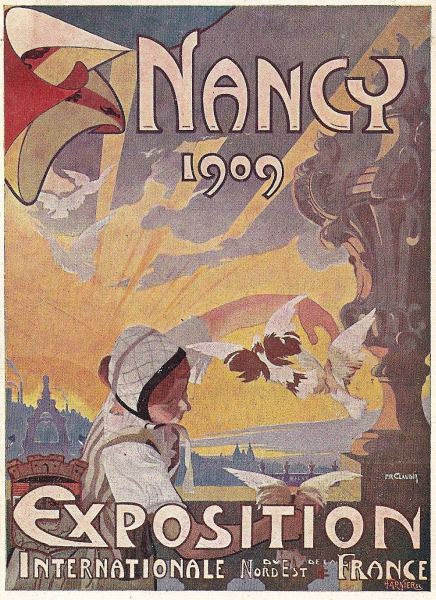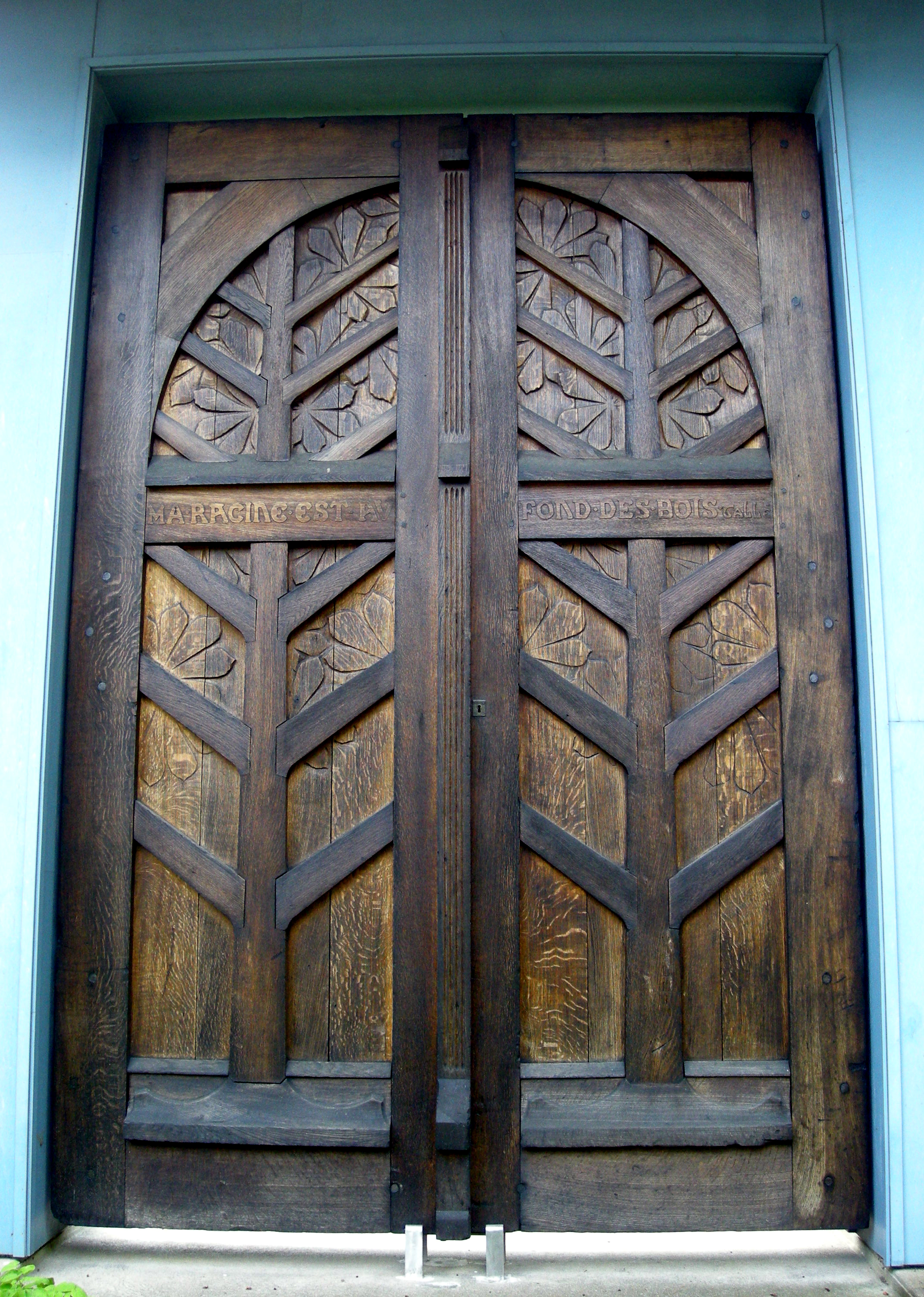|
Exposition Internationale De L'Est De La France
The Exposition Internationale de l'Est de la France or the International Exhibition of the East of France was an exhibition held in Nancy, Meurthe-et-Moselle, Nancy in 1909. The exhibition opened on May 1 and ran until October 31. The exhibition was held to demonstrate recovery from the Alsace-Lorraine annexation in the Franco-Prussian War, 1870 war. There were over 2000 exhibitors and 2 million visitors. Visitor attractions included a water chute, French gardens, a mining and gas pavilions. There was an Alsatian Village and a Senagalese village The local École de Nancy had its own pavilion intended to demonstrate the close links between art and industry in the region which opened two months after the main exhibition. Many architects of the École de Nancy, including Lucien Weissenburger, Émile André, Émile Toussaint, Louis Marchal, Paul Charbonnier, Eugène Vallin, and others designed the pavilions for the exhibition. See also * Musée de l'École de Nancy * Human zoo Ref ... [...More Info...] [...Related Items...] OR: [Wikipedia] [Google] [Baidu] |
Exposition Nancy 1909 Affiche Claudin
Exposition (also the French for exhibition) may refer to: *Universal exposition or World's Fair *Expository writing **Exposition (narrative) *Exposition (music) *Trade fair *Exposition (album), ''Exposition'' (album), the debut album by the band Wax on Radio *Expository preaching See also *Expo (other) *Expose (other) *Expos {{disambig ... [...More Info...] [...Related Items...] OR: [Wikipedia] [Google] [Baidu] |
Eugène Vallin
Eugène Vallin (1856 – 21 July 1922) was a French furniture designer and manufacturer, as well as an architect. Life and career Vallin was born at Herbéviller, and studied at the École des Beaux-Arts in Nancy. He was apprenticed in the studio of his uncle, also a furniture maker, beginning in 1881. His first projects were for church interiors and furniture but quickly he became a disciple of Art Nouveau, in part under the influence of Émile Gallé, for whom he created the door of Gallé's new studios. But he was most famous for his furniture, designing entire living rooms and dining room ensembles for notable personalities in Nancy, including Jean-Baptiste "Eugène" Corbin, Charles Masson, Albert Bergeret, and others. In 1895-6, he built a new studio and his own house on the Boulevard Lobau in Nancy, which became what is now considered (in a crude form) the first Art Nouveau edifice in the city with the help of his friend, architect Georges Biet. In return, Vallin was re ... [...More Info...] [...Related Items...] OR: [Wikipedia] [Google] [Baidu] |
Nancy, France
Nancy ; Lorraine Franconian: ''Nanzisch'' is the Prefectures in France, prefecture of the northeastern Departments of France, French department of Meurthe-et-Moselle. It was the capital of the Duchy of Lorraine, which was Lorraine and Barrois, annexed by France under King Louis XV in 1766 and replaced by a Provinces of France, province, with Nancy maintained as capital. Following its rise to prominence in the Age of Enlightenment, it was nicknamed the "capital of Eastern France" in the late 19th century. The metropolitan area of Nancy had a population of 511,257 inhabitants at the 2018 census, making it the 16th-largest functional area (France), functional urban area in France and Lorraine's largest. The population of the city of Nancy proper is 104,885. The motto of the city is , —a reference to the thistle, which is a symbol of Lorraine. Place Stanislas, a large square built between 1752 and 1756 by architect Emmanuel Héré under the direction of Stanislaus I of Poland to lin ... [...More Info...] [...Related Items...] OR: [Wikipedia] [Google] [Baidu] |
Cultural Infrastructure Completed In 1909
Culture () is an umbrella term which encompasses the social behavior, institutions, and norms found in human societies, as well as the knowledge, beliefs, arts, laws, customs, capabilities, and habits of the individuals in these groups.Tylor, Edward. (1871). Primitive Culture. Vol 1. New York: J.P. Putnam's Son Culture is often originated from or attributed to a specific region or location. Humans acquire culture through the learning processes of enculturation and socialization, which is shown by the diversity of cultures across societies. A cultural norm codifies acceptable conduct in society; it serves as a guideline for behavior, dress, language, and demeanor in a situation, which serves as a template for expectations in a social group. Accepting only a monoculture in a social group can bear risks, just as a single species can wither in the face of environmental change, for lack of functional responses to the change. Thus in military culture, valor is counted a typical be ... [...More Info...] [...Related Items...] OR: [Wikipedia] [Google] [Baidu] |
Art Nouveau Architecture In Nancy, France
Art is a diverse range of human activity, and resulting product, that involves creative or imaginative talent expressive of technical proficiency, beauty, emotional power, or conceptual ideas. There is no generally agreed definition of what constitutes art, and its interpretation has varied greatly throughout history and across cultures. In the Western tradition, the three classical branches of visual art are painting, sculpture, and architecture. Theatre, dance, and other performing arts, as well as literature, music, film and other media such as interactive media, are included in a broader definition of the arts. Until the 17th century, ''art'' referred to any skill or mastery and was not differentiated from crafts or sciences. In modern usage after the 17th century, where aesthetic considerations are paramount, the fine arts are separated and distinguished from acquired skills in general, such as the decorative or applied arts. The nature of art and related concepts, such ... [...More Info...] [...Related Items...] OR: [Wikipedia] [Google] [Baidu] |
1909 In France
Events from the year 1909 in France. Incumbents *President: Armand Fallières *President of the Council of Ministers: Georges Clemenceau (until 24 July), Aristide Briand (starting 24 July) Events *20 February - The Futurist Manifesto, written by Italian Filippo Marinetti, is published in ''Le Figaro''. * 2 February - The Paris Film Congress opens. It is an attempt to form a cartel of leading European producers similar to that of the MPPC in the United States *18 April - Joan of Arc is beatified in Rome. *25 July - Louis Bleriot is the first man to fly across the English Channel in a heavier-than-air craft. *30 July – Société Française de teintures inoffersires, as predecessor of L'Oréal was founded. *22 September - Three of the Chauffeurs de la Drome are executed by guillotine in Valence, Drôme in south-west France. They were a gang responsible for a three-year campaign of theft, torture and murder in the department of Drôme. Sport *5 July - Tour de France begins. ... [...More Info...] [...Related Items...] OR: [Wikipedia] [Google] [Baidu] |
Human Zoo
Human zoos, also known as ethnological expositions, were public displays of people, usually in a so-called "natural" or "primitive" state. They were most prominent during the 19th and 20th centuries. These displays sometimes emphasized the supposed inferiority of the exhibits' culture, and implied the superiority of "Western society", through tropes that purported marginalized groups as "savage". The idea of a "savage" derives from Columbus's voyages that deemed European culture remained pure, while other cultures were titled impure or "wild", and this stereotype relies heavily on the idea that different ways of living were "cast out by God", as other cultures do not recognize Christianity in relation to Creation. Throughout their existence such exhibitions garnered controversy over their demeaning, derogatory, and dehumanizing nature. They began as a part of circuses and "freak shows" which displayed exotic humans in a manner akin to a caricature which exaggerated their differe ... [...More Info...] [...Related Items...] OR: [Wikipedia] [Google] [Baidu] |
Musée De L'École De Nancy
The Musée de l'École de Nancy is a museum devoted to the École de Nancy, an Art Nouveau movement founded in 1901 by Émile Gallé, Victor Prouvé, Louis Majorelle, Antonin Daum and Eugène Vallin in the city of Nancy in Lorraine, north-eastern France. They were joined by other artists, notably Jacques Grüber. The museum, opened in 1964, is set in the former house of a patron of the École de Nancy, Eugène Corbin. The architect was Lucien Weissenburger Lucien Weissenburger (2 May 1860 – 24 February 1929) was a French architect. Weissenburger was born and died in Nancy. He was one of the principal architects to work in the Art Nouveau style in Lorraine and was a member of the board of .... It has a garden, an aquarium pavilion, and the main building contains works by all the major Art Nouveau artists of Nancy, which was one of the major centers of the movement in Europe. Gallery Musée de l'École de Nancy 2018o.jpg Musée de l'École de Nancy 2018p.jpg Mu ... [...More Info...] [...Related Items...] OR: [Wikipedia] [Google] [Baidu] |
Paul Charbonnier
Paul may refer to: *Paul (given name), a given name (includes a list of people with that name) *Paul (surname), a list of people People Christianity *Paul the Apostle (AD c.5–c.64/65), also known as Saul of Tarsus or Saint Paul, early Christian missionary and writer *Pope Paul (other), multiple Popes of the Roman Catholic Church *Saint Paul (other), multiple other people and locations named "Saint Paul" Roman and Byzantine empire *Lucius Aemilius Paullus Macedonicus (c. 229 BC – 160 BC), Roman general *Julius Paulus Prudentissimus (), Roman jurist *Paulus Catena (died 362), Roman notary *Paulus Alexandrinus (4th century), Hellenistic astrologer *Paul of Aegina or Paulus Aegineta (625–690), Greek surgeon Royals *Paul I of Russia (1754–1801), Tsar of Russia *Paul of Greece (1901–1964), King of Greece Other people *Paul the Deacon or Paulus Diaconus (c. 720 – c. 799), Italian Benedictine monk *Paul (father of Maurice), the father of Maurice, Byzan ... [...More Info...] [...Related Items...] OR: [Wikipedia] [Google] [Baidu] |
Nancy, Meurthe-et-Moselle
Nancy ; Lorraine Franconian: ''Nanzisch'' is the Prefectures in France, prefecture of the northeastern Departments of France, French department of Meurthe-et-Moselle. It was the capital of the Duchy of Lorraine, which was Lorraine and Barrois, annexed by France under King Louis XV in 1766 and replaced by a Provinces of France, province, with Nancy maintained as capital. Following its rise to prominence in the Age of Enlightenment, it was nicknamed the "capital of Eastern France" in the late 19th century. The metropolitan area of Nancy had a population of 511,257 inhabitants at the 2018 census, making it the 16th-largest functional area (France), functional urban area in France and Lorraine's largest. The population of the city of Nancy proper is 104,885. The motto of the city is , —a reference to the thistle, which is a symbol of Lorraine. Place Stanislas, a large square built between 1752 and 1756 by architect Emmanuel Héré under the direction of Stanislaus I of Poland to lin ... [...More Info...] [...Related Items...] OR: [Wikipedia] [Google] [Baidu] |
Louis Marchal , names sometimes translated to English as "Louis"
{{disambiguation ...
Louis may refer to: * Louis (coin) * Louis (given name), origin and several individuals with this name * Louis (surname) * Louis (singer), Serbian singer * HMS ''Louis'', two ships of the Royal Navy See also Derived or associated terms * Lewis (other) * Louie (other) * Luis (other) * Louise (other) * Louisville (other) * Louis Cruise Lines * Louis dressing, for salad * Louis Quinze, design style Associated names * * Chlodwig, the origin of the name Ludwig, which is translated to English as "Louis" * Ladislav and László - names sometimes erroneously associated with "Louis" * Ludovic, Ludwig, Ludwick, Ludwik Ludwik () is a Polish given name. Notable people with the name include: * Ludwik Czyżewski, Polish WWII general * Ludwik Fleck (1896–1961), Polish medical doctor and biologist * Ludwik Gintel (1899–1973), Polish-Israeli Olympic soccer player ... [...More Info...] [...Related Items...] OR: [Wikipedia] [Google] [Baidu] |





